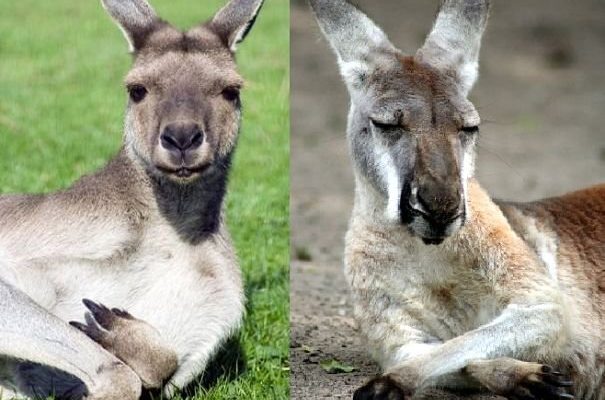![Comparing The Western Grey Kangaroo Vs. [Similar Species]](https://gudri.com/wp-content/uploads/2025/06/Comparing_The_Western_Grey_Kangaroo_Vs___Similar_Species__image_0.jpg)
Picture this: you’re sitting with a friend over coffee, talking about these fascinating creatures. Both kangaroos can be seen bouncing across the Australian landscape, but they have their own distinct habits and traits. Let’s explore how they differ and what makes each of them unique. You might be surprised by what you learn!
Physical Differences Between the Two Species
One of the first things you might notice when comparing the Western Grey Kangaroo and the Eastern Grey Kangaroo is their size and color. The Eastern Grey is generally larger, standing up to 1.8 meters (about 6 feet) tall when fully grown. They have a more muscular build and can weigh between 40 to 66 kilograms (about 88 to 145 pounds). Conversely, the Western Grey is a bit smaller, typically around 1.3 meters (around 4.3 feet) tall, and weighs between 30 to 54 kilograms (about 66 to 119 pounds).
In terms of color, you can often identify these kangaroos by their fur. The Eastern Grey has a soft, greyish-brown coat, while the Western Grey features a more sandy or light brown color. The differences in their physical traits also play a role in their habitats and behaviors, which we’ll dive into a little later.
Habitat Preferences
Where these kangaroos call home also points out some striking differences. The Eastern Grey Kangaroo prefers the more lush, open forests and grasslands found along the eastern coast of Australia. Think of rolling hills, shady trees, and plenty of grass for grazing. Here’s the thing: this environment supports a rich ecosystem that allows them to thrive.
On the other hand, the Western Grey Kangaroo tends to inhabit drier, more arid areas. They’re often found in scrublands and open grasslands in Western Australia. They’re quite adaptable and can survive in scattered bushland where food is scarce. It’s fascinating how their environments reflect their survival tactics.
Behavioral Differences
When it comes to behavior, the two species also diverge quite a bit. The Eastern Grey Kangaroo is more social. You’ll often find them in larger groups, called mobs, which can range from a few to over a hundred kangaroos. These mobs help protect them from predators and provide social interaction.
In contrast, the Western Grey Kangaroo is generally more solitary or found in smaller groups. They prefer to keep things low-key, which helps them conserve energy and avoid overgrazing in their drier habitats. Honestly, it’s interesting how their lifestyles differ based on their surroundings!
Dietary Preferences
Now let’s munch on something a bit more appetizing—food! Both kangaroo species are herbivores that love a good meal of grass and leaves. But they have their quirks. The Eastern Grey tends to prefer the more nutritious grass found in their lush habitats, while the Western Grey has evolved to eat the tougher, dried grasses found in arid regions.
You might be wondering how this affects their diet. Well, the Eastern Grey’s preference for lush grass often means they require more water to sustain themselves, while the Western Grey is able to survive with less frequent access to water. This adaptability is pretty impressive!
Breeding and Offspring
Breeding seasons also differ between these two kangaroo species. The Eastern Grey Kangaroo typically breeds year-round, with a peak in the warmer months. This allows them to have multiple joeys at different stages of development. They usually give birth to a single joey, which will spend about eight months in the mother’s pouch before venturing out.
The Western Grey Kangaroo, however, has a more defined breeding season, generally between June and August. They, too, only give birth to one joey at a time but can delay the development if conditions aren’t right. This ability to pause growth is crucial for ensuring that the joey survives when resources are scarce.
Conservation Status
When we talk about these kangaroos, we also need to touch on their conservation status. Both the Eastern Grey Kangaroo and the Western Grey Kangaroo are classified as “least concern,” which is great news! They are relatively stable in their populations thanks to their adaptability and the fact that they’re native to Australia.
However, habitat loss due to urbanization and farming poses a threat to both species. Conservation efforts are essential to maintain their habitats and ensure they don’t become endangered down the line. Protecting these creatures is not just about kangaroos—it’s about keeping the entire ecosystem balanced.
Final Thoughts: Why Understanding Differences Matters
So, why does it matter to know the differences between the Western Grey Kangaroo and the Eastern Grey Kangaroo? Understanding these distinctions helps us appreciate the richness of biodiversity and the unique adaptations each species has made to thrive in their environments.
Whether you’re planning a trip to Australia or just curious about its wildlife, knowing about these kangaroos gives you a deeper connection to the natural world. They’re not just hopping around aimlessly—each species has a story to tell and a role to play in their ecosystem.
Next time you think about kangaroos, you can share your newfound knowledge and impress your friends over coffee! Isn’t that what being curious is all about?

